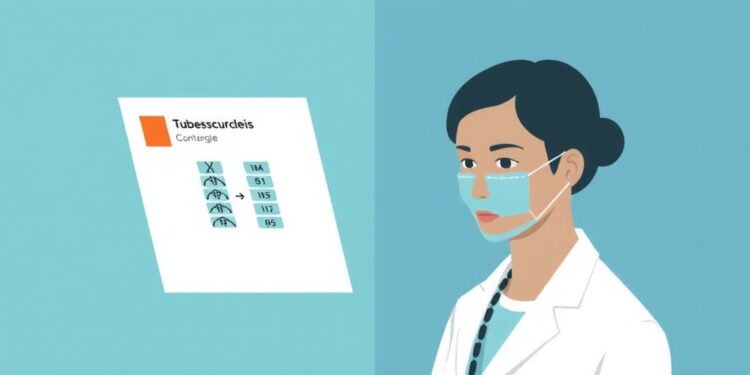In a groundbreaking endeavor, researchers at Massachusetts General Hospital (MGH) have developed a new clinical decision support tool aimed at improving the evaluation of patients suspected of having tuberculosis (TB). This initiative, titled “TB or Not TB,” facilitates an efficient framework for clinicians to assess TB risk in patients, allowing for more accurate decisions related to isolation protocols in healthcare settings. As cases of TB have increasingly risen in the United States, this tool emerges as a critical advancement in infection prevention measures, enhancing both patient safety and healthcare efficiency.
At the helm of this research are Dr. Caitlin Dugdale and Dr. Kimon Zachary, both esteemed physicians in the Division of Infectious Diseases at MGH and assistant professors at Harvard Medical School. Their extensive study is documented in the journal Infection Control and Hospital Epidemiology, where they delve into the methodology behind this innovative risk scoring tool. The study was co-authored by Erica Shenoy, the Chief of Infection Control at Mass General Brigham, whose leadership in infection control adds a vital layer of authority to the project.
The foundation of the tool lies in a meticulous review of historical patient data. By examining the records of individuals diagnosed with TB alongside those identified as high-risk who ultimately tested negative, the research team constructed a robust risk scoring model. This model was rigorously validated to ensure its efficacy, allowing for sound clinical judgments regarding the discontinuation of isolation precautions. Such an approach not only boosts the confidence of clinicians in their assessments but also safeguards the wellbeing of patients and healthcare workers alike.
Integration of this tool into the electronic health record systems at MGB sites simplifies its deployment. The designation of “TB-Risk” alerts clinicians to the necessary precautions upon patient admission. Once clinical evaluations are concluded and evidence suggests a low likelihood of TB infection, providers can readily utilize the “TB or Not TB” tool to determine the appropriateness of ending isolation measures. This intuitiveness enhances the practicality of clinical decision-making in urgent scenarios where TB risk is a factor.
What distinguishes this tool further is its impressive prospective analysis capabilities. Over six years, the researchers examined thousands of TB evaluations across the MGB system. The results were illuminating; the tool demonstrated a perfect identification rate for confirmed TB cases, ensuring that no patient who tested positive for TB was prematurely released from isolation. Simultaneously, it indicated a significant number of cases where TB infection was highly improbable, allowing these patients to safely transition from isolation more swiftly.
The implications for clinical workflow are profound. By leveraging the “TB or Not TB” tool, healthcare facilities can address bed capacity issues that often arise from prolonged isolation periods. With efficient patient management, the strain on resources lessens, enabling hospitals to provide more timely care to a greater number of patients. Furthermore, healthcare providers experience reduced administrative burdens, freeing them to concentrate on direct patient care, which ultimately boosts professional satisfaction and wellbeing.
As the tool garners validation and acceptance within the healthcare community, the team behind its development views this as merely the beginning. Future expansions of this approach contemplate the inclusion of additional infectious diseases, thereby broadening the scope of clinical decision support tools available to healthcare providers. The evolution of such technologies reflects the ongoing commitment of medical professionals to enhance patient safety through data-driven decision-making processes.
In summary, the “TB or Not TB” tool exemplifies the intersection of medicine, technology, and patient care, showcasing how innovative approaches in clinical decision support can significantly reshape infection control strategies in healthcare settings. As TB cases continue to pose a challenge in the U.S., this tool stands as a beacon of hope, underscoring the potential for improved patient outcomes through refined clinical assessments and efficient use of isolation protocols.
Today, as healthcare systems strive to respond to infectious disease challenges pragmatically, the success of the “TB or Not TB” tool marks a pivotal stride toward optimizing patient care while upholding stringent safety measures. The initial findings support continued focus on integrating evidence-based tools into clinical practice to achieve superior health outcomes while protecting the interests of both patients and healthcare workers alike.
This new study encourages further research and optimization of infection control tools, fostering a culture of innovation and adaptability in healthcare. As we navigate the complexities of managing infectious diseases, collaboration among experts from various disciplines will prove essential in safeguarding public health and enhancing the quality of care delivered in hospitals across the nation.
Subject of Research: Clinical decision support tool for tuberculosis evaluation.
Article Title: TB or Not TB? A New Clinician Decision Support Tool for Tuberculosis.
News Publication Date: 2-Jan-2025.
Web References:
References: Dugdale, C. M., Zachary, K. C., Craig, R. L., Doms, A., Germaine, L., Green, C. V., Gulbas, E., Hurtado, R. M., Hyle, E. P., Jerry, M. S., Lazarus, J. E., Maxfield, S., Paras, M., Swanson, K., & Shenoy, E. S. (2025). TB or not TB? Development and validation of a clinical decision support system to inform airborne isolation requirements in the evaluation of suspected tuberculosis. Infection control and hospital epidemiology, 1–9. Advance online publication.
Image Credits:
Keywords: Tuberculosis, Clinical Decision Support, Infection Control, Healthcare Efficiency, Risk Assessment.
Tags: airborne infection isolation protocolsDr. Caitlin Dugdale tuberculosis studyDr. Kimon Zachary infectious diseaseshealthcare efficiency measuresInfection Control and Hospital Epidemiology journalinfection prevention in healthcareMassachusetts General Hospital researchnovel tuberculosis diagnostic toolspatient safety in tuberculosisrising tuberculosis cases in the United StatesTB risk assessment frameworktuberculosis clinical decision support tool





